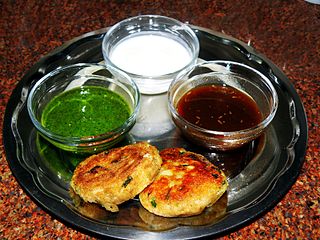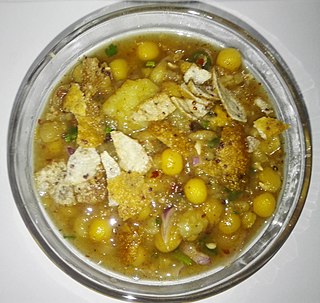
A samosa is a fried or baked pastry with a savoury filling, such as spiced potatoes, onions, peas, cheese, beef and other meats, or lentils. It may take different forms, including triangular, cone, or half-moon shapes, depending on the region. The Indian style, often accompanied by a chutney, is probably the most widely known of a broad family of recipes from Africa to China, which have origins in medieval times or earlier. Samosas are a popular entrée, appetizer, or snack in the local cuisines of South Asia, Western Asia, Southeast Asia, the Mediterranean, and Africa. Due to emigration and cultural diffusion from these areas, samosas today are often prepared in other regions.

Dahi vada is a type of chaat (snack) originating from the Indian subcontinent and popular throughout South Asia. It is prepared by soaking vadas in thick dahi (yogurt).

Bombay mix or Chanachur or Chiwda is an Indian snack mix (namkeen) which consists of a variable mixture of spicy dried ingredients, such as fried lentils, peanuts, chickpea flour ghatia (sev), corn, vegetable oil, chickpeas, flaked rice, fried onion and curry leaves. This is all flavored with salt and a blend of spices that may include coriander and mustard seed.

Panipuri or Phuchka or Gupchup is a type of snack that originated in India, and is one of India's most common street foods.

Chaat or chat is a savoury snack that originated in India, typically served as an hors d'oeuvre at roadside tracks from stalls or food carts across the Indian subcontinent in India, Pakistan, Nepal, and Bangladesh. With its origins in Uttar Pradesh, India, chaat has become immensely popular in the rest of the Indian subcontinent. The word derives from Hindi cāṭ चाट, from cāṭnā चाटना, from Prakrit caṭṭei चट्टेइ.

Puri is a deep-fat fried bread made from unleavened whole-wheat flour that originated in the Indian subcontinent. It is eaten for breakfast or as a snack or light meal. It is usually served with a savory curry or bhaji, as in puri bhaji, but may also be eaten with sweet dishes.

Puffed rice is a type of puffed grain made from rice, commonly used in breakfast cereal or snack foods. It is usually made by heating rice kernels under high pressure in the presence of steam, though the method of manufacture varies widely.

Maharashtrian or Marathicuisine is the cuisine of the Marathi people from the Indian state of Maharashtra. It has distinctive attributes, while sharing much with other Indian cuisines. Traditionally, Maharashtrians have considered their food to be more austere than others.

Gujarati cuisine is that of the state of Gujarat, in western India.

Odia Cuisine is the cuisine of the state of Odisha. It has developed over time with local culture and agriculture and hence has its distinct items and practices. Odisha borders both north Indian states and south Indian states and consequently is similar to the cuisines of North India, Bengal and Assam as well.

Dahipuri, or dahi puri, is a snack, originating from India, which is especially popular in the state of Maharashtra, India. The dish is a form of chaat and originates from the city of Mumbai. It is served with mini-puri shells (golgappa), which are more popularly recognized from the dish pani puri. Dahi puri and pani puri chaats are often sold from the same vendor.

Bhojpuri cuisine is a part of North Indian cuisine and a style of food preparation common amongst the Bhojpuri people of Bihar and Uttar Pradesh. Bhojpuri foods are mostly mild and are less hot in term of spices used, but could be hotter and spicier according to individual preference. The food is tailor-made for Bhojpuri lifestyle in which the rural folk burn up a lot of calories in the fields. Bhojpuri people take pride in celebrating various festivals and religious rites with food; as a result, their food resembles the delicacies offered to deities.

Awadhi cuisine is a cuisine native to the Awadh region in Northern India. The cooking patterns of Lucknow are similar to those of Central Asia, the Middle East, and Northern India with the cuisine comprising both vegetarian and non-vegetarian dishes. The Awadh region has been greatly influenced by Mughal cooking techniques, and the cuisine of Lucknow bears similarities to those of Central Asia, Kashmir, Punjab and Hyderabad. The city is also known for its Nawabi foods.

Aloo tikki is a snack originating from the Indian subcontinent; in North Indian, Pakistani and Bangladeshi preparation, it is made out of boiled potatoes, peas, and various curry spices. "Aloo" means potato, and the word "tikki" means a small cutlet or croquette in Hindi and Marathi. It is served hot and warm along with a side of saunth, tamarind and coriander-mint sauce, and sometimes dahi (yogurt) or chick peas. It is a vegetarian alternative, and an Indian equivalent of the hash brown.

Telugu cuisine is a cuisine of South India native to the Telugu people from the states of Andhra Pradesh and Telangana. Generally known for its tangy, hot and spicy taste, the cooking is very diverse due to the vast spread of the people and varied topological regions.

Sev puri is an Indian snack and a type of chaat. It is a speciality that originates from Pune, Maharashtra, India.

Sev is a popular Indian snack food consisting of small pieces of crunchy noodles made from chickpea flour paste, which are seasoned with turmeric, cayenne, and ajwain before being deep-fried in oil. These noodles vary in thickness. Ready-to-eat varieties of sev, including flavoured sev, are available in Indian stores.

Chotpoti, is a Bengali street food mostly popular in Bangladesh and West Bengal, along with other urban areas. The word chotpoti, translates to 'spicy.'

Masala puri, or Masalpuri, is an Indian snack which is especially popular in the southern states of Karnataka, Tamil Nadu, Telangana and Andhra Pradesh. A form of chaat, the dish originated in the Indian state of Karnataka and has now become famous in the entire Indian subcontinent. Typically spicy, the dish can also be made sweet based on the requirement.

Jhalmuri is a popular Bengali street snack, made of puffed rice and an assortment of spices, vegetables, chanachur and mustard oil. It is especially popular in the West Bengal state of India and in the neighbouring country Bangladesh. It became popular in London when a british chef called Angus Denoon tried this snack in Kolkata and started selling it on streets of London. Popularity of Jhalmuri has also reached other western cities like New York City through the Bangladeshi diaspora.
























